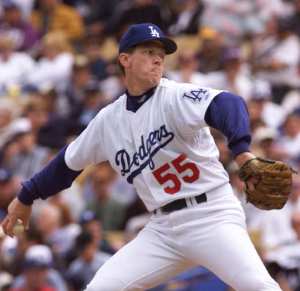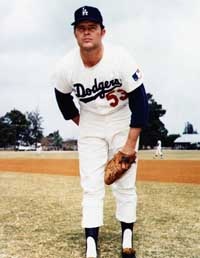While Bob Gibson was putting together the greatest pitching season in the modern era, Don Drysdale put together his own with an unprecedented streak of scoreless innings. From May 10 through June 8, Drysdale threw six complete game shutouts and ran his scoreless streak to 58 innings. The big right hander would pitch well all year, but would only manage two additional shutouts in all of his other starts in 1968. Still, those six consecutive shutouts were amazing.
 In 1988, another Dodgers hurler, Orel Hershiser would do one inning better, recording 59 scoreless innings to end the season. In that stretch, “Bulldog” would record five complete game shutouts. He would throw another three in his other starts that season. Hershiser will also score additional bonus points for those 59 scoreless innings late in the race for the NL West division title, when the games took on additional meaning.
In 1988, another Dodgers hurler, Orel Hershiser would do one inning better, recording 59 scoreless innings to end the season. In that stretch, “Bulldog” would record five complete game shutouts. He would throw another three in his other starts that season. Hershiser will also score additional bonus points for those 59 scoreless innings late in the race for the NL West division title, when the games took on additional meaning.
What you may not know is that Bob Gibson put together his own streak of scoreless innings in 1968. If not for a couple of bloop hits, he might have eclipsed both Drysdale’s and Hershiser’s records by an unbelievable margin.
 It all begins in New York on June 2, 1968. Through no fault of Gibson’s, he entered this game with a losing record of 3-5, despite giving up no more than 3 earned runs in any start. Gibson would face an old Cardinals favorite, Al Jackson, who had been sent back to the Mets as the player to be named later in the emergency deal for Jack Lamabe when Gibson broke his leg in 1967. With a big 6-2 lead, Gibson was setting down Mets hitters at an alarming pace. In the seventh inning, Ed Charles leads off with a pinch hit home run. That makes the score 6-3, which would end up being the final tally on the day. Gibson would earn his fourth win of the season, but more importantly would throw two scoreless innings to end the game.
It all begins in New York on June 2, 1968. Through no fault of Gibson’s, he entered this game with a losing record of 3-5, despite giving up no more than 3 earned runs in any start. Gibson would face an old Cardinals favorite, Al Jackson, who had been sent back to the Mets as the player to be named later in the emergency deal for Jack Lamabe when Gibson broke his leg in 1967. With a big 6-2 lead, Gibson was setting down Mets hitters at an alarming pace. In the seventh inning, Ed Charles leads off with a pinch hit home run. That makes the score 6-3, which would end up being the final tally on the day. Gibson would earn his fourth win of the season, but more importantly would throw two scoreless innings to end the game.
In his next 5 starts, Gibson would throw complete game shutouts against Houston, Atlanta, Cincinnati, Chicago and Pittsburgh. Including the two innings to finish the game in New York, that is 47 consecutive scoreless innings.
That brings us to July 1 where Gibson would face Don Drysdale in Los Angeles. In the bottom of the first inning, Len Gabrielson and Tom Haller would each hit singles, neither of them hit particularly hard. With runners at first and third and two outs, Gibson would throw a pitch Johnny Edwards couldn’t handle, and Gabrielson would score on the wild pitch. Gibson would complete the game without allowing another run, beating Drysdale and the Dodgers by the score of 5-1. Gibson’s first scoreless inning streak would end with 47, but he started a new one with the last 8 from this game.
On July 6, Gibson would throw another complete game shutout, this time in San Francisco. His second scoreless inning streak is now up to 17.
Gibson’s next start would be a Friday night game, at home, against the Houston Astros. In the top of the seventh inning, Rusty Staub would hit a single to left field. After striking out Jimmy “The Toy Cannon” Wynn, the light hitting Dennis Menke hits a double, scoring Staub all the way from first base. Once again, a weak single followed by a double led to a run, breaking Gibson’s second scoreless streak at 23 innings. And like before, that would be the only run in the game as Gibson starts a new scoreless inning streak with the last 2 innings.
Gibson follows that up with two more complete game shutouts at home against the Mets and Phillies. His third scoreless inning streak is now up to 20 innings. He would extend that to 23 innings before a two out bloop single by Ed Charles (the same Ed Charles that started the first streak with a pinch hit home run on June 2) and a double by Ed Kranepool broke the streak with a run. As with the other three games, this would be the only run allowed in the game.
This would all come to an end on August 4, at home against the Chicago Cubs. Gibson would throw 4 scoreless innings before getting tagged for a pair of runs in the fifth inning. Even those hits were grounders, but enough of them clustered together to go along with a Mike Shannon error to snap the last scoreless inning streak. And if there was any doubt, Billy Williams would hit a home run in the top of the seventh inning – the first ball that was hit hard off of Gibson in nearly two months.
So let’s put all of this together. In 105 innings pitched from June 2 through August 4, Gibson only allowed three runs, one each in three different games. And each of these came as a result of a bloop hit or a grounder just out of the range in an infielder. 102 of 105 scoreless innings. In Gibson’s remaining 12 starts in 1968, he would throw complete game shutouts in 5 more, including a heroic 10 inning affair for his 20th win in Cincinnati on September 2.
As a young fan watching and listening to Gibson through the 1968 season, I don’t remember many runs being scored that summer. When you actually begin counting up the innings, the numbers become absolutely mind boggling.
With all due respect to Don Drysdale and Orel Hershiser, neither put together anything that comes close to Gibson’s domination between June 2 and Aug 4, 1968. In the time I’ve spent looking at pitching records from other eras, I can’t find anything else that compares to these two months from the Cardinals legend, Bob Gibson.






The more I read and learn about Gibson in 1968 (much of it from you), the more amazed I am at how truly unbelievable he was then. Thanks for the continuing education!
LikeLike
Gibson was amazing! That is one of those records that would get lost if it weren’t for great historians of the game like you! Thanks! Definitely loved this one!
LikeLike